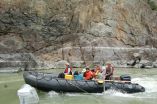(Press-News.org) A small study suggests snakes may have developed courtship and male-to-male combat behavior, such as moving undulations, neck biting, and spur-poking, over time, according to a study published September 24, 2014 in the open-access journal PLOS ONE by Phil Senter from Fayetteville State University and colleagues.
Behaviors involved in courtship and male-to-male combat have been recorded in over 70 snake species from five families in the clade Boidae and Colubroidea, but before now, scientists had yet to look for evolutionary relationships between these behaviors. The authors of this study analyzed 33 courtship and male-to-male combat behaviors in the scientific literature by plotting them to a phylogenetic tree to identify patterns. The authors identified the patterns in behaviors, which was not always possible, and then used the fossil record to match the behaviors to the snakes' evolution.
Researchers found that male-to-male combat of common ancestors of Boidae and Colubridae in the Late Cretaceous likely involved combatants raising the head and neck, attempting to topple each other. Poking with spurs may have been added in the Boidae clade. In the Lampropeltini clade, the toppling behavior was replaced by coiling without neck-raising, and body-bridging was added. Snake courtship likely involved rubbing with spurs in Boidae. In Colubroidea, courtship ancestrally involved chin-rubbing and head- or body-jerking. Various colubroid clades subsequently added other behaviors, like moving undulations in Natricinae and Lampropeltini, coital neck biting in the Eurasian ratsnake clade, and tail quivering in Pantherophis. Although many gaps in the evolution of courtship and combat in snakes remain, this study provides a first step in reconstructing the evolution of these behaviors in snakes.
INFORMATION:
In your coverage please use this URL to provide access to the freely available paper: http://dx.plos.org/10.1371/journal.pone.0107528
Citation: Senter P, Harris SM, Kent DL (2014) Phylogeny of Courtship and Male-Male Combat Behavior in Snakes. PLoS ONE 9(9): e107528. doi:10.1371/journal.pone.0107528
Funding: The authors have no support or funding to report.
Competing Interests: The authors have declared that no competing interests exist.
Evolution of snake courtship and combat behavior
Snakes developed Spur-poking, body-bridging behavior over time
2014-09-24
ELSE PRESS RELEASES FROM THIS DATE:
From rats to humans: Project NEUWalk closer to clinical trials
2014-09-24
Lausanne, Switzerland. EPFL scientists have discovered how to control the limbs of a completely paralyzed rat in real time to help it walk again. Their results are published today in Science Translational Medicine.
Building on earlier work in rats, this new breakthrough is part of a more general therapy that could one day be implemented in rehabilitation programs for people with spinal cord injury, currently being developed in a European project called NEUWalk. Clinical trials could start as early as next summer using the new Gait Platform now assembled at the CHUV ...
Immune activity shortly after surgery holds big clue to recovery rate, Stanford team finds
2014-09-24
The millions of people who undergo major surgery each year have no way of knowing how long it will take them to recover from the operation. Some will feel better within days. For others, it will take a month or more. Right now, doctors can't tell individual patients which category they'll fit into.
Now, researchers at the Stanford University School of Medicine have discovered that the activity level of a small set of immune cells during the first 24 hours after surgery provides strong clues to how quickly patients will bounce back from surgery-induced fatigue and pain, ...
Stanford scientists use stem cells to learn how common mutation in Asians affects heart health
2014-09-24
Over 500 million people worldwide carry a genetic mutation that disables a common metabolic protein called ALDH2. The mutation, which predominantly occurs in people of East Asian descent, leads to an increased risk of heart disease and poorer outcomes after a heart attack. It also causes facial flushing when carriers drink alcohol.
Now researchers at the Stanford University School of Medicine have learned for the first time specifically how the mutation affects heart health. They did so by comparing heart muscle cells made from induced pluripotent stem cells, or iPS ...
The plus side of population aging
2014-09-24
Around the world, people are living longer and having fewer children, leading to a population that is older, on average, than in the past. On average, life expectancy in developed countries has risen at a pace of three months per year, and fertility has fallen below replacement rate in the majority of Europe and other developed countries.
Most academic discussion of this trend has so far focused on potential problems it creates, including challenges to pension systems, economic growth, and healthcare costs.
But according to a new study published today in the journal PLOS ...
Brain scans reveal 'gray matter' differences in media multitaskers
2014-09-24
Simultaneously using mobile phones, laptops and other media devices could be changing the structure of our brains, according to new University of Sussex research.
A study published today (24 September) reveals that people who frequently use several media devices at the same time have lower grey-matter density in one particular region of the brain compared to those who use just one device occasionally.
The research supports earlier studies showing connections between high media-multitasking activity and poor attention in the face of distractions, along with emotional ...
Colorado's Front Range fire severity not much different than past, say CU study
2014-09-24
The perception that Colorado's Front Range wildfires are becoming increasingly severe does not hold much water scientifically, according to a massive new study led by the University of Colorado Boulder and Humboldt State University in Arcata, Calif.
The study authors, who looked at 1.3 million acres of ponderosa pine and mixed conifer forest from Teller County west of Colorado Springs through Larimer County west and north of Fort Collins, reconstructed the timing and severity of past fires using fire-scarred trees and tree-ring data going back to the 1600s. Only 16 percent ...
New dinosaur from New Mexico has relatives in Alberta
2014-09-24
(Edmonton) A newly discovered armoured dinosaur from New Mexico has close ties to the dinosaurs of Alberta, say University of Alberta paleontologists involved in the research.
From 76 to 66 million years ago, Alberta was home to at least five species of ankylosaurid dinosaurs, the group that includes club-tailed giants like Ankylosaurus. But fewer ankylosaurids are known from the southern parts of North America. The new species, Ziapelta sanjuanensis, was discovered in 2011 in the Bisti/De-na-zin Wilderness area of New Mexico by a team from the New Mexico Museum of Natural ...
A way to kill chemo-resistant ovarian cancer cells: Cut down its protector
2014-09-24
Ottawa, Canada – September 24, 2014 – Ovarian cancer is the most deadly gynecological cancer, claiming the lives of more than 50% of women who are diagnosed with the disease. A study involving Ottawa and Taiwan researchers, published today in the influential Proceedings of the National Academy of Sciences (PNAS), provides new insight into why ovarian cancer is often resistant to chemotherapy, as well as a potential way to improve its diagnosis and treatment.
It is estimated that 2,700 Canadian women will be diagnosed with ovarian cancer in 2014 and that 1,750 Canadian ...
Star Trekish, rafting scientists make bold discovery on Fraser River
2014-09-24
A Simon Fraser University-led team behind a new discovery has "…had the vision to go, like Star Trek, where no one has gone before: to a steep and violent bedrock canyon, with surprising results."
That comment comes from a reviewer about a truly groundbreaking study just published in the journal Nature.
Scientists studying river flow in bedrock canyons for the first time have discovered that previous conceptions of flow and incision in bedrock-rivers are wrong.
SFU geography professor Jeremy Venditti led the team of SFU, University of Ottawa and University of British ...
Bacterial 'communication system' could be used to stop and kill cancer cells, MU study finds
2014-09-24
COLUMBIA, Mo. – Cancer, while always dangerous, truly becomes life-threatening when cancer cells begin to spread to different areas throughout the body. Now, researchers at the University of Missouri have discovered that a molecule used as a communication system by bacteria can be manipulated to prevent cancer cells from spreading. Senthil Kumar, an assistant research professor and assistant director of the Comparative Oncology and Epigenetics Laboratory at the MU College of Veterinary Medicine, says this communication system can be used to "tell" cancer cells how to act, ...
LAST 30 PRESS RELEASES:
Numbers in our sights affect how we perceive space
SIMJ announces global collaborative book project in commemoration of its 75th anniversary
Air pollution exposure and birth weight
Obstructive sleep apnea risk and mental health conditions among older adults
How talking slows eye movements behind the wheel
The Ceramic Society of Japan’s Oxoate Ceramics Research Association launches new international book project
Heart-brain connection: international study reveals the role of the vagus nerve in keeping the heart young
Researchers identify Rb1 as a predictive biomarker for a new therapeutic strategy in some breast cancers
Survey reveals ethical gaps slowing AI adoption in pediatric surgery
Stimulant ADHD medications work differently than thought
AI overestimates how smart people are, according to HSE economists
HSE researchers create genome-wide map of quadruplexes
Scientists boost cell "powerhouses" to burn more calories
Automatic label checking: The missing step in making reliable medical AI
Low daily alcohol intake linked to 50% heightened mouth cancer risk in India
American Meteorological Society announces Rick Spinrad as 2026 President-Elect
Biomass-based carbon capture spotlighted in newly released global climate webinar recording
Illuminating invisible nano pollutants: advanced bioimaging tracks the full journey of emerging nanoscale contaminants in living systems
How does age affect recovery from spinal cord injury?
Novel AI tool offers prognosis for patients with head and neck cancer
Fathers’ microplastic exposure tied to their children’s metabolic problems
Research validates laboratory model for studying high-grade serous ovarian cancer
SIR 2026 delivers transformative breakthroughs in minimally invasive medicine to improve patient care
Stem Cell Reports most downloaded papers of 2025 highlight the breadth and impact of stem cell research
Oxford-led study estimates NHS spends around 3% of its primary and secondary care budget on the health impacts of heat and cold in England
A researcher’s long quest leads to a smart composite breakthrough
Urban wild bees act as “microbial sensors” of city health.
New study finds where you live affects recovery after a hip fracture
Forecasting the impact of fully automated vehicle adoption on US road traffic injuries
Alcohol-related hospitalizations from 2016 to 2022
[Press-News.org] Evolution of snake courtship and combat behaviorSnakes developed Spur-poking, body-bridging behavior over time



